
 |
|
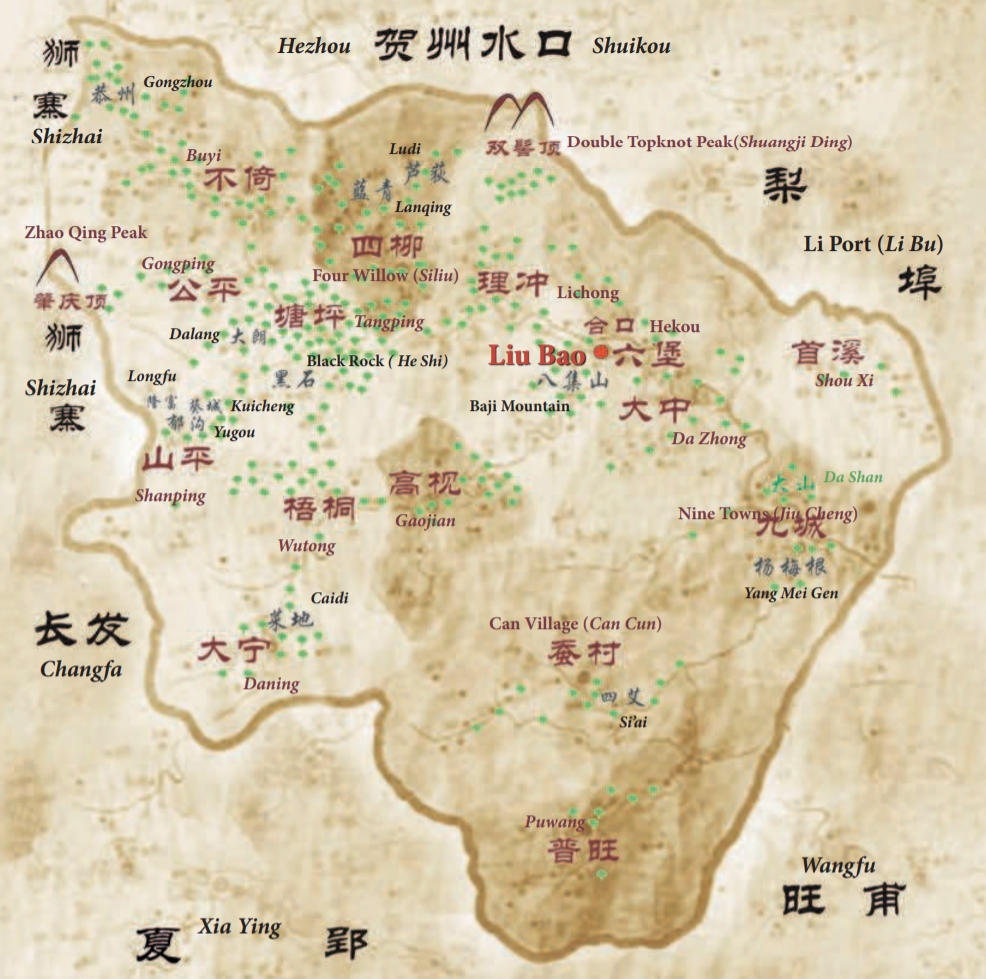
The concept of terroir, the influence of specific locales and environmental conditions, is important when it comes to Liu Bao tea. When we talk about which mountain, or shantou (山頭) a certain Liu Bao comes from, we're not necessarily referring to a particular mountain. We really mean a very specific location within the Liu Bao growing area: It could be a hillside plantation, or several continuous hills, or a small area several kilometers in perimeter. Varying conditions in the growing environment can produce noticeable differences in the tea, so teas from each location have their own unique characteristics. Some of the factors that influence this are the geographical features of the plantation (whether it's located on a mountain, the lower slopes or a plateau), the local vegetation, soil and differences between communities of tree/plant varieties. These features of terroir must be analyzed once the leaf from various regions has been gathered and processed in a standardized fashion.
When people refer to the "original" Liu Bao tea plant varietal (原種六堡 茶), they mean a sexually-reproducing varietal that is native to the original tea tree communities growing in Liu Bao Village, and has a long history of being grown in the area. It's often referred to as the "original" Liu Bao tea plant to distinguish it from the region's other introduced varietals that are also suited to producing Liu Bao tea. According to a 1959 Record of Superior Crops in the Guangxi Zhuang Autonomous Region, it is sometimes also called "narrow-leaf tea" by the locals, to distinguish it from large-leaf varietals. In Guangdong dialect, it is also called "cha'er (茶儿)." The Dictionary of Chinese Tea, edited by scholar Chen Zongmao (陳宗懋), also contains the following entry on Liu Bao tea, on page 101: "Liu Bao tea is a tea plant varietal that reproduces sexually. It is early sprouting and bush-like in shape, with medium-sized leaves and dense, spreading branches. The leaves are green and elliptical, and have flat surfaces with a slight outward bulge; the blade is flat, and the leaf is of medium quality. The buds and leaves are light green in color, with the occasional appearance of purple. They are not very downy, and remain tender for quite a while. The trees output a medium quantity of leaves. They are quite resistant to cold and drought. The original Liu Bao tea plant varietal grows all over the Liu Bao region."
Historically, small amounts of this varietal either currently grow or once grew in the following parts of Guangxi Province: Wu Bao Village (Shizhai) and Changfa in Cangwu County; Shatian, Shuikou, Daping, Shidong, Mingmei, Chaping and Qingshui in the neighboring city of Hezhou; and in the nearby counties of Cenxi, Mengshan and Zhaoping. The same goes for some parts of the neighboring Guangdong Province, including Luoding, Huaji and particulary the areas bordering the Xijiang River, such as Fengkai, Yu'nan, Gaoyao and Yunfu. (Some of these places are listed in The Study of Tea Production, China Agricultural Publishing House, 1961.)
From quite early on, people began paying attention to the place of origin when judging the quality of Liu Bao; although it grew in a lot of places, "authentic Liu Bao tea" grown in the Liu Bao region itself was the most highly regarded. Many sources mention the fact that "Wu Bao and Si Bao also produce tea." (These place names literally mean "Five Castles" and "Four Castles," while Liu Bao means "Six Castles.") The Guangxi General Annals observes that "in terms of excellence, the villages of Liu Bao and Wu Bao are superior; Liu Bao is particulary famous." In an article in the seventh issue of the second edition of China Tea Knowledge (1951), author Su Haiwen (蘇海文) mentions that "Wu Bao tea is mainly sold at the major Southeast Asian ports; on average the price is around 10 - 20% lower than the price of Liu Bao." The older generations of local Chajin recall that in the past, tea from Liu Bao itself was also classified according to where it was grown. The most famous tea-growing spots were Heishi in Tangping, Ludi in Siliu, and Gongzhou in Buyi. Some of the Liu Bao brand names from these places that became quite popular in Hong Kong and Macau included Heishi, Xiadou, Yingji and Guang Yuan Tai. The place names Lichong, Shanping and Tangping were also widely recognized as synonymous with excellent quality.



The reason behind Liu Bao Village's stand-out quality was its geography: Liu Bao is situated in a mountainous region on the northern side of the Tropic of Cancer, with an average elevation of 250 meters above sea level. It is bordered by Libu to the east, Shizhai to the west, Xiaying and Wangfu to the south, and Hezhou and Shuikou to the north. Throughout the region, nineteen mountain peaks tower above the densely forested landscape. The northwest, west and southwest parts of the Liu Bao region are mountainous with few fields; located here are the main historical Liu Bao tea-producing centers of Tangping, Lichong, Siliu, Buyi, Shanping, Gongping, Daning, Wutong and Gao. In addition, there are the lower-lying regions, with wider valleys and more fertile soil, which produce bamboo, timber and rice, as well as Liu Bao tea in places; these include Hekou, Dazhong, Shouxi, Jiucheng, Puwang and Cancun.
The total area of the Liu Bao region is around 300,269 hectares, of which about 93% is made up of hilly or mountainous terrain. Higheraltitude hills between 250 - 500 m above sea level cover around 52% of the total area, while mountainous terrain of 500 - 800 m in altitude encompasses around 33%. So, as you can tell, the region's tea-growing areas are largely located on mountains and hills. Due to erosion of sandstone and shale, the soil in the Liu Bao tea region has a high sand content; it is a slightly acidic, medium loam, with loose topsoil. The soil found below 450 m in altitude tends to be mountainous red or yellow-red soil, while from 450 - 700 m this gives way to transitional red-yellow soil. The average temperature in the tea region is 19 - 20 °C. The western parts of the region, including Tangping, Siliu, Buyi, Shanping and Gongping, are relatively high altitude, with high humidity and a big difference between daytime and nighttime temperatures. Outside of the slightly clearer season from May to August, the region is generally blanketed in thick fog, with scenic landscapes of clouds and mist enveloping and swirling around the mountains.
Because of the differences created by the terrain, rivers, soil and microclimate, the various parts of the Liu Bao tea region all produce tea with distinct characteristics. Historically, the original Liu Bao tea plants in the region were all bred using the fruit of the tea plants to carry out propagation through sexual reproduction, which increased diversity among the varietals in the region. This means that even between individual trees in various populations, you can see differences in leaf shape and color, with some redand purple-leafed varietals scattered throughout. The difference is especially noticeable between geographically distant production areas: for example, red-leafed and purple-leafed varietals are more common in the mountain plantations of Siliu, Buyi and so on. The teas grown in different regions also have their own distinctive flavor and aroma.


We can summarize the differences between teas from various parts of Liu Bao by dividing the area into four regions:
This region borders the river that it's named for, and includes Hekou, Dazhong, Jiucheng and the surrounding districts. It produces a fair volume of Liu Bao, and the local tea is characterized by its rich, mellow flavor and full-bodied aroma.
This region encompasses Daning, Gao and Wutong. Historically, it produced a high volume of Liu Bao tea. The area is home to the Wutong River, which flows from the tail ends of the Daning and Jiuchong rivers; it also features two tall mountains, Chongyuan Peak and Piaoshan Peak. The local Liu Bao is known for its attractive color and smooth taste, with a gentle flavor and a distinctive aroma.
This area is home to Buyi, Siliu, Lichong, Gongping, Tangping and Shanping. The terrain here is largely mountains and hills. The Buyi River flows through Tian and Tangping, and combines the Siliu and Lichong tributaries. Historically, this area was an important center for Liu Bao tea production, and it includes well-known tea regions, such as Tangping (which encompasses the Heishi tea region), Buyi (home to the Gongzhou tea region), Siliu (home to the Ludi tea region), Lichong and Shanping. Famous historical Liu Bao brands such as Heishi tea (黑石茶), Xiadou tea (蝦鬥茶), Gongzhou tea (恭州茶) and Ludi tea (蘆荻茶) all come from this region.
The northwest region is also famed for its "Four Great Mountains," which were associated with the most wellknown Liu Bao tea brands. The Heishi "Black Stone" region below Tangping's Heishi Mountain produced Heishi tea, while Shuangji "Double Topknot" Mountain, at an elevation of 757 m, overlooks the areas of Siliu and Lichong, which produced Xiadou tea. At the base of Moduan "Ink Hall" Peak (altitude 596 m), Sanzuo "Three Points" Peak (altitude 406 m) and Shuangji Mountain lay the areas of Ludi, known for its Ludi tea, and the area of Buyi, including Gongzhou and Dailong Mountain, which produced Gongzhou tea.
The Cangwu County Records, published during the reign of the Qing Emperor Tongzhi, note that "Liu Bao Village produces excellent tea, with a rich flavor that does not fade when left overnight. The Xiadou area produces a tea called Xiadou tea, with a wonderful color and flavor, although it is slightly lighter." As we can see in this description, Liu Bao tea (including Heishi, Ludi and Gongzhou) is known for its stronger flavor, while Xiadou tea is described as "wonderful," even outstanding, in terms of flavor, color and fragrance. Its only unfavorable comparison being in terms of strength of flavor. Overall, this shows that Xiadou tea was very highly regarded.
As well as making a broad comparison of the four tea-producing regions of Liu Bao, we can also take a more indepth look at the tea from each area. For example, we can say that Heishi tea, Ludi tea and Gongzhou tea all have a strong flavor, but in fact, these teas all display a slightly different style of "strength." Heishi tea is characterized by its "thick," dense flavor, with a forceful energy and a "mountainous" fragrance. It has a power and strength to it, and a deep, resounding fragrance. So, we could think of these three different types of strength as thickness, depth and power. Ludi tea, on the other hand, is characterized by its pure, broad flavor and fragrance, and its honest, spirited energy. We can think of its strength as thick, broad and pure. Gongzhou tea is known for its rich mellowness, with a strong flavor and full fragrance; it goes down smoothly and has an abundant energy and an elegant charm. Its three types of strength can be described as rich, mellow and full-bodied. In the northwest parts of the Liu Bao region, there are also many other mountainous areas famed throughout history for producing "strong flavored" Liu Bao tea, including Caodui, Lishai, Sangao, Tianhong, Huangsun and Zhaoqing, as well as Gongping and Shanping, near Zhaoqing Peak.



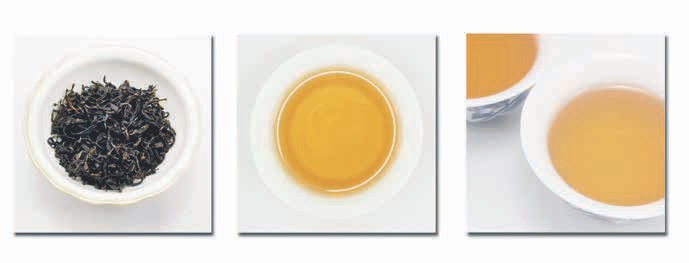
Since the early days, Heishi tea has enjoyed wide repute for its rich, strong flavor and robust energy. Its distinguishing characteristics are its density of flavor and potent energy, with a unique "mountain" flavor. The Heishi Liu Bao that we tasted had been aged for four years. It has a rich, mellow flavor, a substantial fragrance, a shiny yellow-orange luster and a robust energy. It displays the famed "mountain" aroma, which becomes even more noticeable after five steepings. It has a lingering flavor and charm that stays in the mind for a long time. The leaf is even and uniform, and the craftsmanship is authentic. With a longer period of suitable storage, it is likely to improve even further - it will be well worth the wait.
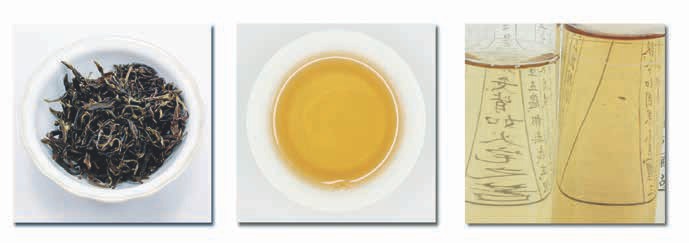
Ludi tea is a well-known Liu Bao - all the associated places such as Dibang, Diwei and Lanqing make excellent tea. Ludi tea is characterized by its strength, pure flavor and simple aroma. This Ludi was a new tea, aged for around two years, and the liquor was yellow in color with a hint of green. It has a simple fragrance and a concentrated flavor, with a broad, lingering aftertaste. It has an honest, spirited energy, and a great potential for aging. All in all, it's a great representative example of Ludi tea.

Lichong has historically been a main center for Liu Bao tea production, and makes excellent tea, with a fine reputation among tea lovers. Lichong tea is known for its gentle flavor and strong energy, with a light, elegant fragrance. It is quite a patient tea. The Lichong Liu Bao that we tasted was a spring tea. It is bright yellow with a greenish tint, with a strong flavor and a fine smoothness in the throat. It has the fresh scent of a new tea, with a robust energy, a mellow flavor and a noticeably sweet aftertaste. It's a great quality tea, with a strong potential for development as it ages.

The Cangwu County Records from the reign of the Qing Emperor Tongzhi contain this passage: "Xiadou tea has a wonderful color, flavor and aroma, though it is just a little light." This reflects a very high opinion of Xiadou tea at the time. This description of the tea as "a little light" is likely given in comparison to the "strong" flavors of Heishi, Ludi and Gongzhou tea. To look at it from another angle, "light" can also imply a delicate, refined flavor and a refreshing mouthfeel. So in reality, this relative "lightness" is not seen as a flaw, but rather as a difference in style. I acquired this particular Xiadou tea from an elderly Chajin native to Liu Bao; it had been personally stored for several decades by Xiadou tea master Chen Yongchang (陳永昌). The leaf was carefully chosen Lichong tea, and was processed authentically. In terms of the tea liquor, it was truly the essence of the description in the Cangwu County Records, with a "wonderful color, flavor and aroma." It was a clear, deep red, and filled the room with a wonderful aged tea aroma on the first steeping. After ten steepings, it was as if the fragrance had accumulated inside the tea; the aroma was prominent when swallowing, and lingered in the mouth for a long time. Although the tea was from a long-ago vintage, its inner quality shone through in the flavor and aroma. This really was an outstanding Liu Bao tea, and absolutely worthy of its reputation as one of the most famed teas of its generation!

Gongzhou was the old name for what is now the eastern part of Yatang in Buyi and the surrounding tea-growing areas. Authentic Gongzhou tea is known for its mellowness, with a strong flavor, a multi-layered fragrance and a robust energy. It has a full and harmonious feel in the throat, and a gentle charm to it. This particular tea from Yatang in Buyi was a spring tea, a classic example of Gongzhou tea. Since it's a new tea, the liquor was a greenish-yellow color, with a strong flavor, mellow and sweet with a hint of bitterness. It has a brief, sweet aftertaste and a flavor that lingers in the throat. It noticeably displays the sweet scent of new tea, with a faint hint of the fragrance that is unique to this tea variety, and a robust energy. The buds and leaves in the brewed tea are sturdy, indicating a well-made tea; it has great storage potential.

Historically, Tangping was one of the most important Liu Bao tea-growing areas, and produced a very high volume of tea. Tangping has quite a diverse range of different styles of tea, and the leaf from the original Liu Bao tea plant varietals in the area is of very high quality. (In recent years, due to the promotion of planting certain tea varieties, a small amount of tea of the "Guangxi Number 1 Green" variety has also been planted in the area, so one must be careful to distinguish these two varieties.) Original Liu Bao tea from Tangping has a good flavor and a robust energy, and displays a well-developed fragrance quite quickly when aged. It has a sweet, gentle flavor, a soft mouthfeel and an elegant aroma. This particular Liu Bao tea was made from Dalang leaf and aged for nearly five years. The liquor has already become a clear yellow, with a strong flavor and a note of sweetness. It has a harmonious flavor and a subtle, long-lasting fragrance, which was still faintly present after five steepings. It's an excellent quality tea.
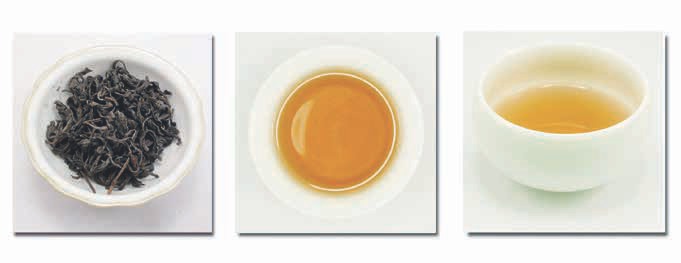
The people of Shanping are of the Yao ethnicity. The Liu Bao tea produced there is a good quality, patient tea with a smooth flavor, highly esteemed among Chajin. The leaf for this particular tea came from Longfu in Shanping, and had been aged for five years. It has a mellow flavor reminiscent of betel nut, with a reddish-brown liquor and a lasting fragrance. This tea was most likely harvested from above the Longfu mountain ridge. The flavor is harmonious yet not insipid; the mouthfeel is thick but not overbearing. The liquor is still fragrant and flavorful after five steepings, and even after fifteen, it doesn't lose its flavor. The aroma is simple and pleasant, the brewed tea leaves are neat and even, and the buds plump. It's a very promising example of Shanping tea.
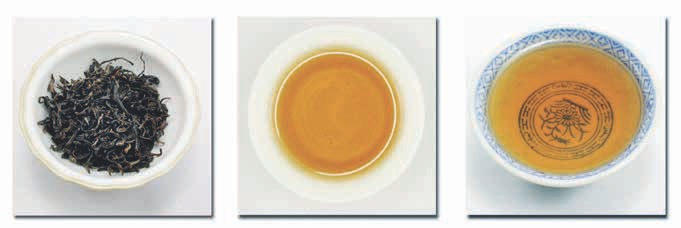
Wutong tea is characterized by its mild flavor, delicate liquor and sweet aftertaste, accompanied by a pleasant sensation in the throat. It has quite a unique aroma. In comparison to Liu Bao teas from other places, the tea from Wutong, Daning and Gao displays slightly more rapid changes in color and flavor when aged. This tea was about three years old. Before brewing, the dry leaves were neat, even and tightly curled. After pouring the water, you can see that the liquor has already turned a reddish-brown color, similar to what you'd observe from a four- or five-year-old tea from elsewhere. It has a clear liquor and a mild flavor. It's a good quality tea, with a sweet, mellow flavor and a hidden fragrance contained within the leaves. Observing the brewed leaves revealed that the tea is made authentically, from fine, carefully selected leaves, which displays Wutong tea's unique characteristics very well.
Through the practice of tea-making over the years, we have come to realize the importance of many factors in determining the quality of Liu Bao tea, from soil quality and cultivation, to the season and timing of harvesting, to processing techniques such as kill-green and rolling. For example, tea harvested after the rains will be less bold in flavor; Liu Bao tea planted on mountain ridges and hillsides will be rich and fragrant, while tea planted in fields with fertilizers high in nitrogen will end up with a weaker fragrance, lacking in flavor and spirit (the locals call this "tea from the belly of the fields"). In addition, if the kill-green step is left too late, the leaves may begin to oxidize and turn red, influencing the flavor of the tea. If the temperature is not properly controlled during killgreen, the leaves may burn; in the drying process, too, the temperature and intensity of the fire can influence the aroma of the tea. If the firewood used during kill-green, drying or storage produces thick smoke, this can also lead to a smoky flavor in the tea. All these factors can directly influence the character and quality of the tea. So, there's a lot that goes into the making of a quality Liu Bao: we must start in a good tea region, on a good mountain, with good planting techniques and good processing methods. With the great diversity present within the Liu Bao tea region, if we wish to take an objective look at tea from the "Four Great Mountains," we must appreciate the differences between the many varieties of Liu Bao tea, and judge each tea based on its own unique characteristics.

